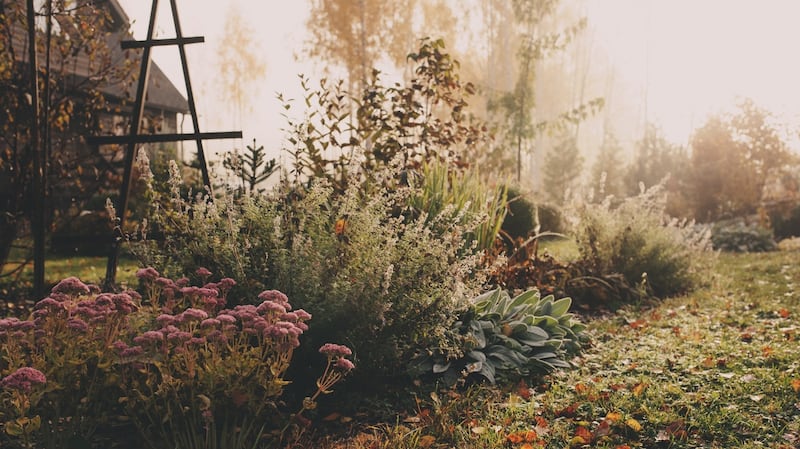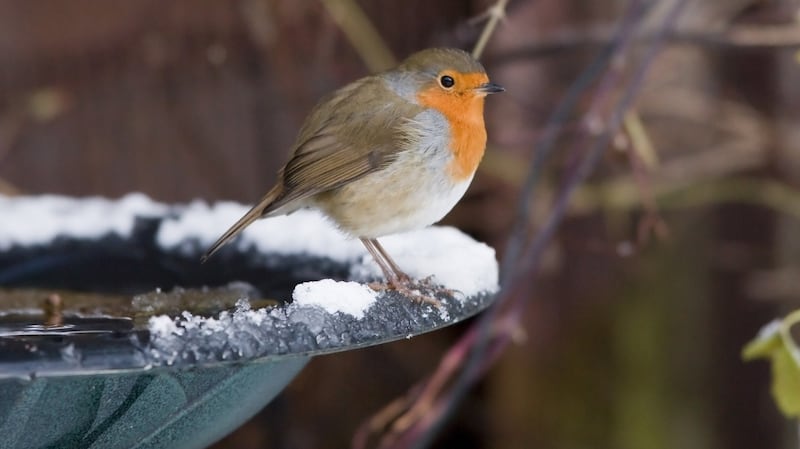If the quintessential summer garden is the frothy, floaty equivalent of a pretty summer dress, then the best kind of winter garden is like a classic winter coat; elegantly tailored yet comfortable on the coldest of days.
How to create that look in your own garden? My first piece of advice is to forget – or at least push to the back of your mind – the ephemeral beauty of flowers. Instead concentrate on a carefully honed selection of hardy plants to provide plenty of enduring seasonal interest in the shape of architectural foliage, colourful bark/branches and handsome winter silhouettes.
Where space allows, that selection should include at least one tree. Classic choices suitable for smaller (but not tiny) gardens include the multi-stemmed silver birch (Betula utilis var. jacquemontii) whose ghostly silver limbs glimmer in the subdued light of an Irish winter’s day; the paper-bark maple (Acer griseum) and the Tibetan cherry (Prunus serrula), both deciduous small trees prized for their richly colourful bark; the evergreen, hugely decorative strawberry tree, which is a great choice for an exposed, coastal garden (Arbutus unedo); and myrtle (Luma apiculata), an evergreen small tree/ large shrub with mottled, cinnamon-coloured bark and aromatic foliage that thrives in milder gardens.


Where space is tight, shrubby species can be used instead of trees to give that same sense of winter structure and seasonal interest, especially if you ”skirt-lift” their lower branches or cloud-prune or topiarise them into interesting shapes. Not only does this create a sculptural winter silhouette – or what I call “plants with attitude” – it also frees up growing space beneath them and allows more light to filter through to the garden.
Examples of evergreen shrubby species suitable for this sort of treatment include the Portuguese laurel (Prunus lusitanica), pittosporum, varieties of Fatsia japonica and Fatsia polycarpa, Pseudopanax laetus, Phillyrea latifolia, bay (Laurus nobilis) and yew (Taxus baccata).
As long as they’re kept watered and fed, many of these shrubs can also be successfully grown in a large tub or very generous-sized pot for many years. So can many species of bamboo, tree ferns (suitable only for milder gardens) and acid-loving/ ericaceous plants such as rhododendron, camellia, skimmia and pieris, all of which can be used to give your garden the sort of lush, leafy, furnished feel that’s so welcome during an Irish winter. Just make sure to give the latter a lime-free/ ericaceous compost when you’re potting them up.

Other plants eminently suitable for winter containers include trailing ivies, box, sarcococca, varieties of Pinus mugo, hellebores, heuchera, heucherella, astelia, evergreen ferns including many different species/ varieties of Polystichum, and evergreen grasses including Carex testacea, Carex comans, Carex oshimensis and the majestic Chionochloa rubra.
As for the containers themselves, go for the largest you can afford – the lightest are made from resin or fibreglass – and stick to a style and colour scheme for maximum effect. Recommended stockists include all good garden centres as well as specialist suppliers such as Simonstown Architectural (simonstownarchitectural.ie).
You can also, budget-permitting, get large pots and containers custom-made to the exact dimensions you require and in the colour of your choice, right down to matching the exact shade of your living-room walls or kitchen cabinets (see dundalkengineering.ie,galco.ie and dunboynepowdercoating.com).
If in doubt, choose neutral/classic shades that won’t date, won’t clash with your indoor furnishings and will provide a handsome foil for your plants. For maximum visual impact, arrange these containers together in a generous cluster.
Plants and pots aside, your garden's bone structure – its paths, paving, walls and/or fencing and the way these have been incorporated within its overall design– will make a huge difference to its appearance in winter. If you think yours is in need of a major redesign, consider employing the help of a professional (see glda.ie). But there are many other simple ways to give it a revamp.
Disguise ugly garden fences and walls by painting/staining them a dark shade of grey or forest-green and planting evergreen climbers or wall shrubs against them. Species/varieties suitable for a bright spot in a sheltered garden include the star jasmine (Trachelospermum jasminoides); Chinese jasmine (Trachelospermum asiaticum), Azara microphylla, Itea ilicifolia, passionflower (Passiflora caerulea) and the lovely Clematis “Winter Beauty” whose fragrant, bell-shaped flowers appear from December to March while many different varieties of climbing ivy will happily grow in a cool, shady garden.
Hang up a variety of well-stocked bird feeders and you'll be rewarded by the sight of your very own avian ballet
Scrub down stained stone paving with a deck brush or pressure-washer and refresh pebble paths with a top-dressing (see landscapedepot.ie). Give garden benches a new lease of life with a fresh lick of paint or alternatively consider investing in a few timeless pieces of garden furniture (see formalityonline.com). A well-chosen piece of outdoor sculpture can also add another layer of interest and give you many years of pleasure (see solomongallery.ie, thekildaregallery.ie, calnan-anhoj.ie).
Don’t forget, also, the transformative power of light; a few garden lights or lanterns can illuminate an outdoor space in subtle yet theatrical ways. Just bear in mind that less is definitely more (“airport runway” is not a good look, nor is it good for garden wildlife).
Heat is important too. On the darkest and gloomiest of winter nights, the warmth and flickering flames of a garden fire-bowl/outdoor brazier or chiminea (see quickcrop.ie) will help to create a special kind of pandemic-defying magic. But just make sure that same heat isn't so close to prized plants that it accidentally scorches their leaves.
Another alternative is to build your very own outdoor, wood-fired clay oven or – as I recently saw being used in the beautiful garden terrace of a private house – to install an outdoor wood-burning stove. To make it as eco-friendly as possible, use properly dried, ethically sourced firewood (once cooled, the wood ash can be added to the compost heap or used as a soil amendment).
Even the smallest things make a huge difference to our enjoyment of the garden at this time of year. Hang up a variety of well-stocked bird feeders (see more below) and you’ll be rewarded by the sight of your very own avian ballet, a never-ending melodrama of flickering wings, sweet courtships and fierce competition.
Add a small birdbath and observe the careful grooming rituals of visiting birds. And the addition of the tiniest of garden ponds might even surprise with the many different wild species that will begin to visit or take up residence, proving that nature is all around us, even in the depths of an Irish winter.

This Week in the Garden…
This is a good time of the year to give flower beds/borders a gentle tidy-up by cutting back the dying foliage of herbaceous perennials (these can go on the compost heap) and clearing away weeds. In drier parts of the country, this is also a good time of the year to lift overcrowded, underperforming summer-flowering perennials as a way of rejuvenating them.
Lift clumps with a garden fork and then either use a sharp knife, small saw or two garden forks (placed back to back into the centre of the clump) to separate the clump into smaller sections. Quickly replant these back into the ground or pot them on, then water well to encourage good root establishment.
Wash, scrub down and disinfect birdfeeders and bird tables before stocking them with a variety of nutritious food (examples include peanuts, nyjer seed, sunflower seeds, fat balls, mealworms, pre-soaked sultanas, sliced apple, naked rolled oats and pinhead oats) to help support wild bird populations.
To help protect visiting birds from predatory cats, bird tables and feeders should ideally be placed at least 2 metres away from any low ground cover and in a spot that provides birds with high leafy cover (for example, the overhanging branches of a tree).
To prevent disease and avoid the risk of attracting rodents, never put out large quantities of food at any one time and always remove any stale loose food from the ground. For more advice on feeding birds in your garden go to birdwatchireland.ie













